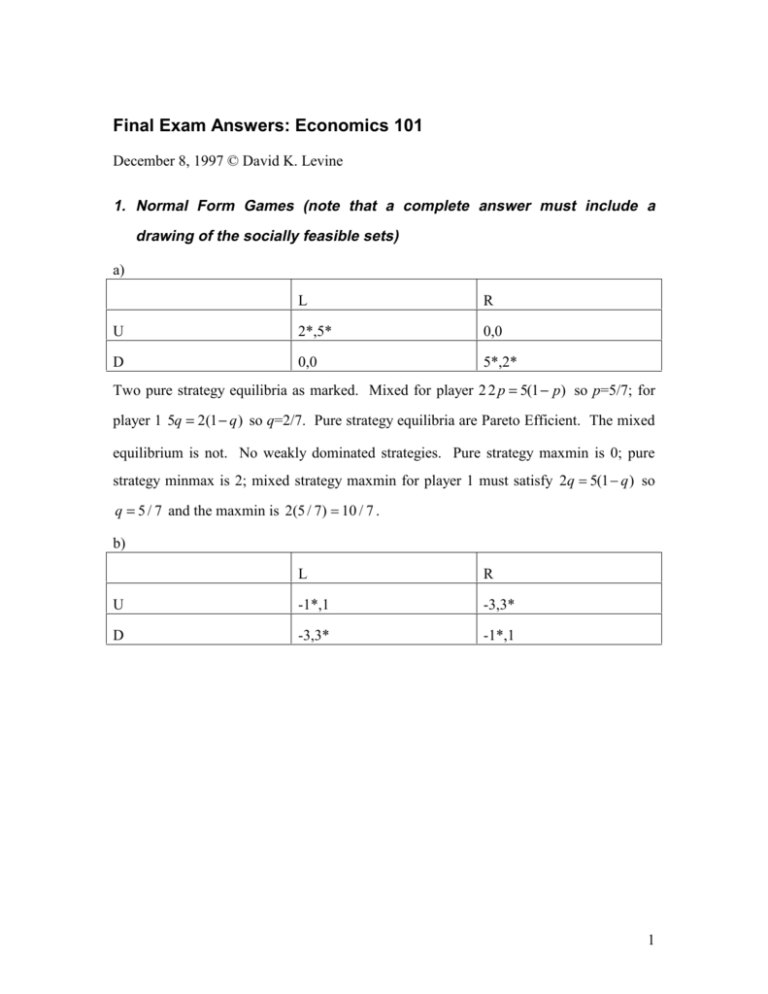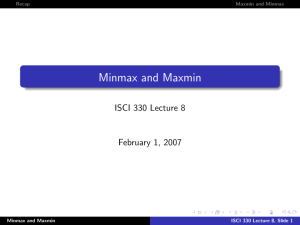Final Exam Answers: Economics 101
advertisement

Final Exam Answers: Economics 101 December 8, 1997 © David K. Levine 1. Normal Form Games (note that a complete answer must include a drawing of the socially feasible sets) a) L R U 2*,5* 0,0 D 0,0 5*,2* Two pure strategy equilibria as marked. Mixed for player 2 2 p = 5(1 - p) so p=5/7; for player 1 5q = 2(1 - q ) so q=2/7. Pure strategy equilibria are Pareto Efficient. The mixed equilibrium is not. No weakly dominated strategies. Pure strategy maxmin is 0; pure strategy minmax is 2; mixed strategy maxmin for player 1 must satisfy 2q = 5(1 − q ) so q = 5 / 7 and the maxmin is 2(5 / 7) = 10 / 7 . b) L R U -1*,1 -3,3* D -3,3* -1*,1 1 No pure strategy equilibrium. Unique pareto efficient mixed equilibrium where both players mix 50-50. No weakly dominated strategies. Note that the socially feasible set is one-dimensional. Pure strategy maxmin for player 1 is –3, for player 2 is 1; pure strategy minmax for player 1 is –1, for player 2 is 3. mixed strategy maxmin is achieved by playing 50-50; for player 1 –2 for player 2 +2. c) L R U 7,7 0,8* D 8*,0 1*,1* Unique Nash equilibrium (U,L are strictly dominated). No mixed equilibria. Nash equilibrium is not pareto efficient. Pure and mixed maxmin and maxmin is 1 for both players. 2. Long Run versus Short Run L R U 3,1* 0,0 D 8*,0 1*,2* The unique Nash equilibrium is DR; the Stackelberg equilibrium is UL. Strategies for which lead to playing UL are UL if always UL in the past and DR if ever a deviation. Alternatively, players may base their strategies on past play of the LR player only: LR: U if U in the past and D if ever a deviation by LR and SR: L if U in the past and R if ever a deviation of the LR player. These are optimal for the short-run player because it is in his best-response correspondence. For the long run player it must be that 3 (1 - d )8 + d 1 or d 5 / 7 . 2 3. Screening (6,1) S (5,0) Sales G MBA C (7,0) Nerd(.5) N R Nrm(.5) (5,0) Sales G MBA C (6,6) S (4,4) Nerd/Nrm S C SS 5,0* 5,0* SM 4.5,2 5.5,3* MS 5.5*,0.5* 6,0 MM 5,2.5 6.5*,3* Two pure equilibria: MS and S; MM and C. Note that for the graduate SS and MS are strictly dominated by MS. So we look for the randomization by R that makes graduate indifferent between MS and MM: 55 . p + 6(1 - p) = 5 p + 6.5(1 - p) or p = 0.25 . Then we look for the randomization between MS and MM that makes R indifferent between S and C. 0.5q + 2.5(1 - q ) = 0q + 3(1 - q ) or q = 0.5 . The corresponding behavior strategy (only Graduate has a difference between behavior and mixed strategy) is get and MBA if nerd 3 and choose MBA with probability 0.5 if normal. Beliefs of recruiter are then 2/3 nerd, 1/3 normal. 4. Decision Analysis without the test payoff from banning all athletes .1x0+.9x(-100)=-90; payoff from allowing all athletes to participate .1x(-50)+.9x10=4, so allow all to participate and get payoff of 4. Test positive probability of user by Bayes law .95×.1 pr (user |+ ) = =.51 pr( + ) =.95×.1+.1×.9 =.185 .95×.1+.1×.9 .05.1 pr (user |- ) = =.006 pr( − ) =.05×.1+.9 ×.9 =.815 .05.1+.9.9 payoff to + and ban .51x0+.49x(-100)=-49; payoff to + and participate .51x(-50)+.49x10=-20.6 so ban and get payoff of –20.6 payoff to – and ban is obviously negative payoff to – and participate is .006x(-50)+.994*10=9.64 overall utility if test is used optimally .185x(-20.6)+.815x9.64=4.05 gain to using test 4.05-4=.05, so pay up to .05 per athlete. Erratum: the answer key is wrong. The first mistake is just a typo, it says that the payoff from ban is -49 and from participate is -20.6, so "ban" and get payoff of -20.6 (it should say so " don’t ban" and get a payoff of -20.6). The main problem however is that the problem was done rounding the payoffs and probabilities yielding a solution of being willing to pay up to $.05 for the test when if done with "all the decimals" you’d get that you would not pay a cent. Just from intuition the answer should be zero, since having the test is not changing our decisions (we are not banning any way). Enrique Flores 4 5. Cournot with Uncertain Cost p i ( xi , ci ) = (1 / 3) 17 - ci - ( xi + x 1 ) xi +(2 / 3) 17 - ci - ( xi + x 3 ) xi maximize dp i ( xi , ci ) = 17 - ci - (2 xi + (1 / 3) x 1 + (2 / 3) x 3 ) = 0 dxi so 2 xi = (17 - ci - (1 / 3) x 1 - (2 / 3) x 3 ) 2 xi = (17 - ci - (1 / 3) x 1 - (2 / 3) x 3 ) 6 xi = (51 - 3ci - x 1 - 2 x 3 ) solve each equation individually 7 x 1 = 48 - 2 x 3 8 x 3 = 42 - x 1 or x 3 = 21 / 4 - x 1 / 8 plug the second into the first 7 x 1 = 48 - 2(21 / 4 - x 1 / 8) = 75 / 2 + x 1 / 8 or x 1 = 60 / 11 substitute back to get x 3 = 201 / 44 Erratum: the answer key is wrong. 7 x 1 = 48 - 2(21 / 4 - x 1 / 8) = 75 / 2 + x 1 / 4 so x 1 = 50 / 9 . Substituting back in we get x 3 = 143 / 36 . Mark Fann 5







